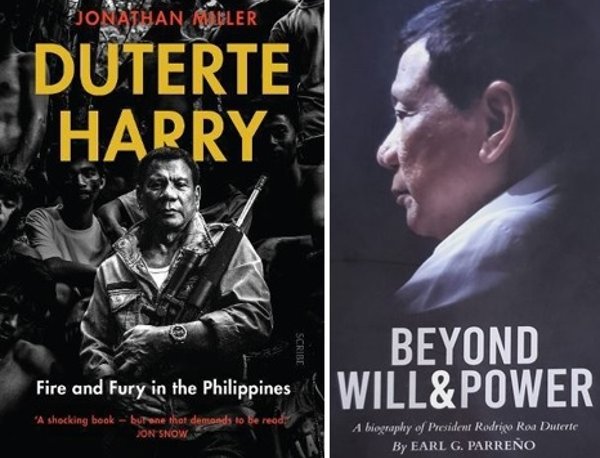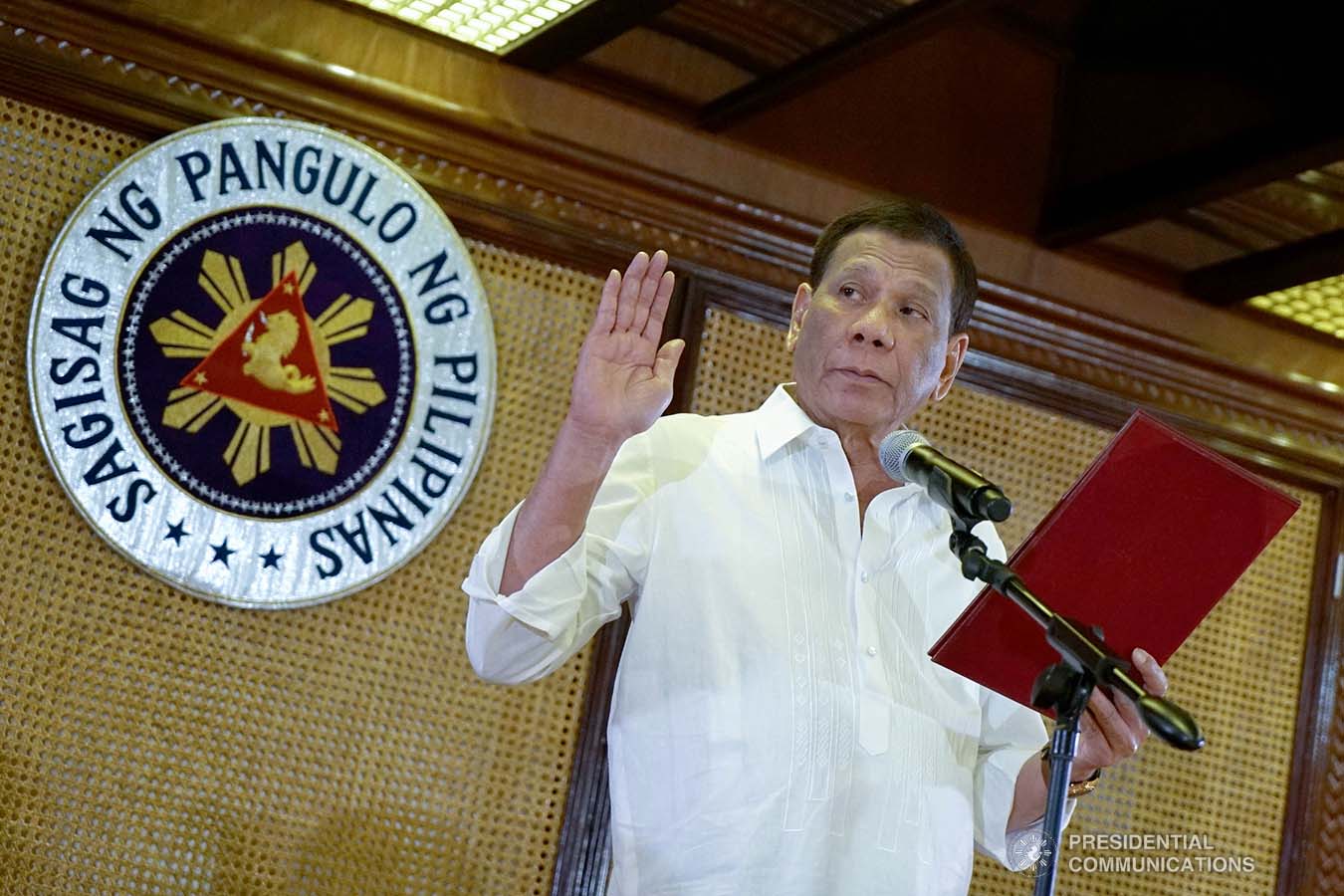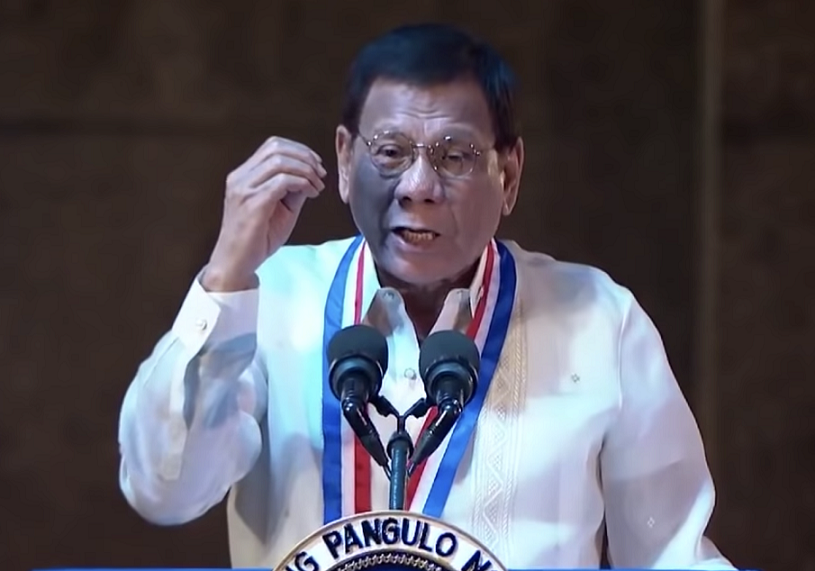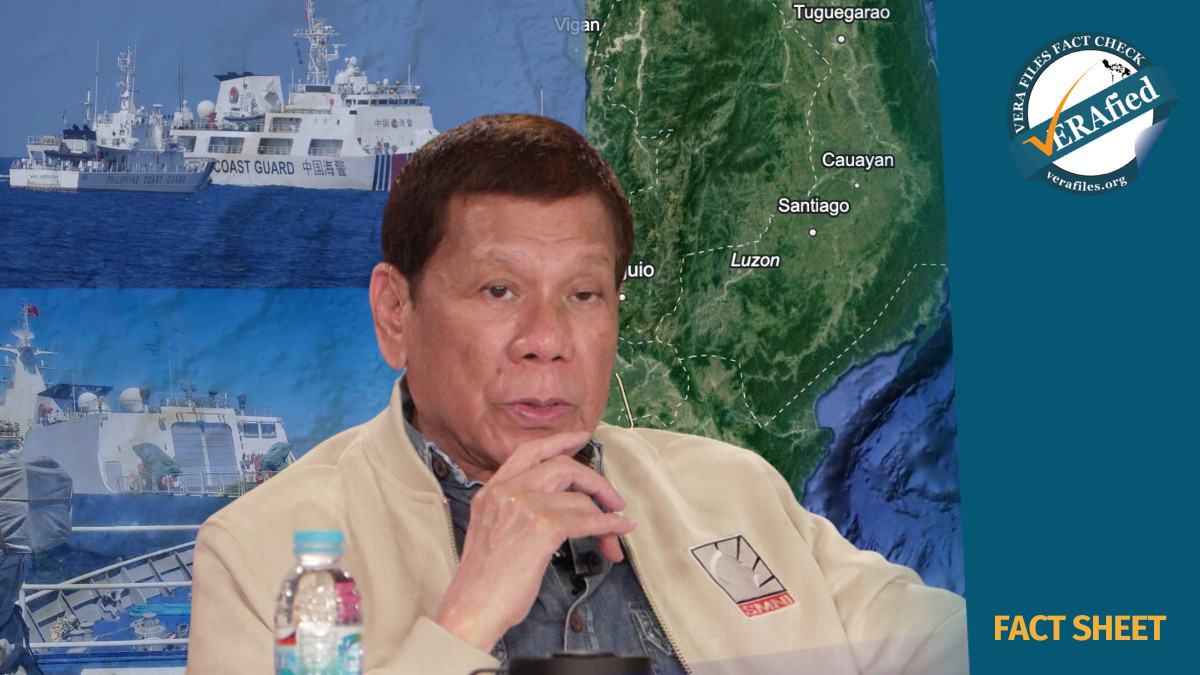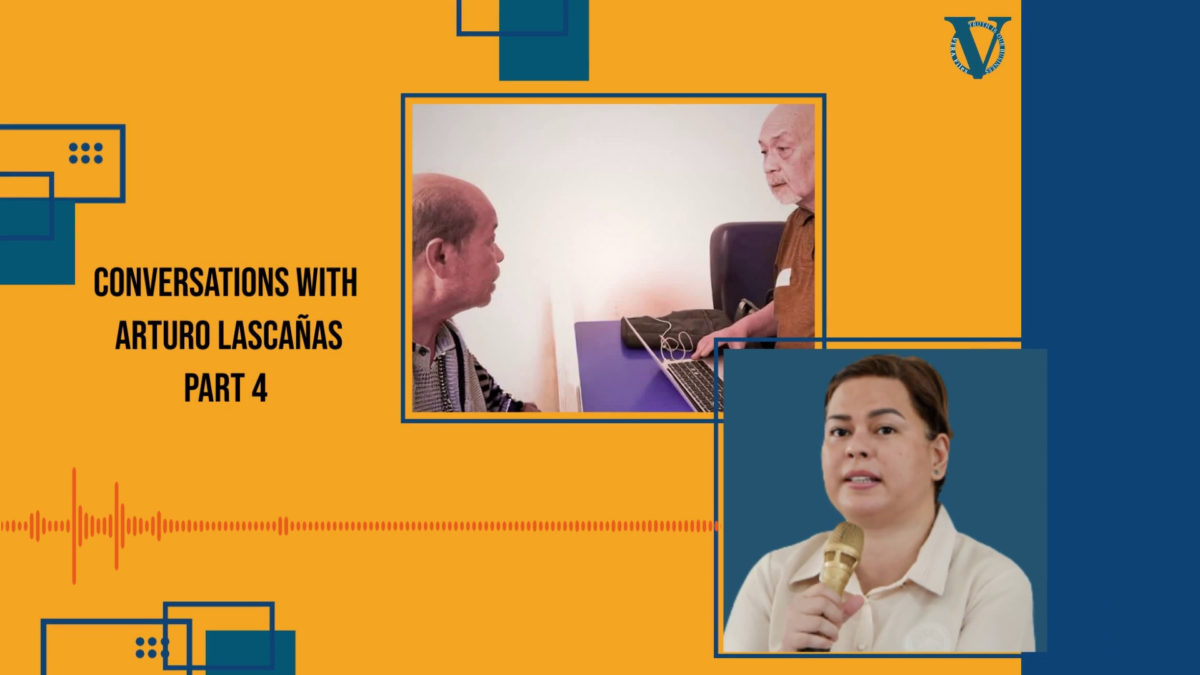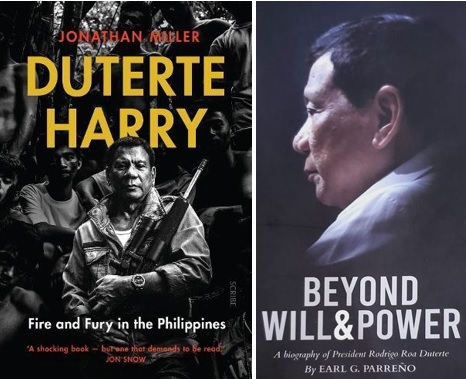
Judging by the sparse review population, there continues to be hardly any broad public interest on two biographies of Rodrigo Duterte that came out in the past two years. The first, Duterte Harry: Fire and Fury in the Philippines (Scribe Publications, London, 2018), was written by the Irish-born author Jonathan Miller, Asia Correspondent for the London-based Channel 4 News. He boasts of some accolades: Royal Television Society awards for his brand of shattering journalistic reportage and four Amnesty International TV News awards. At least one review was published in the Manila Times, written by the London-educated Filipino scholar and columnist Rachel A.G. Reyes.
The other bio, Beyond Will and Power, A Biography of President Rodrigo Roa Duterte, was self-published by its author Earl G. Parreño in 2019. It presents Parreño as a freelance writer who had written in 2003 the book Boss Danding, the unauthorized biography of the late Marcos crony Eduardo Cojuangco. A review was published online by blogger Emmanuel Alejandro, who identifies himself as a former officemate of Parreño in a non-government organization. Reyes also wrote a review of Parreño’s book published in Vera Files.
In the Philippines, political campaigns begin illegally, and stealthily, – long before the filing of candidacies commencing October 2021 for the 2022 elections. Today, each presidential aspirant claims to have a hotline with God, waiting for the Burning Bush appointment to run. If we are not yet lost in the inertia of the hypocrisy, both books should serve as acute cautionary tales reminding us that, soon, we will be voting in a political system laboring under damning corruption and impunity that have even worsened since 2016.
The Laud Quarry: The Dark Secrets of Duterte’s Modus Mortis
The Miller book is written as a field narrative, a pastiche of the Duterte pace and style of life: meandering, loquacious, tautological, ribald. Replete with myriad sources, he interviewed DDS and non-DDS, Duterte family members, cabinet secretaries with their glorifying hosannas, SunStar Davao editor in-chief Stella Estremera, who he styles as “not impartial” (“an acolyte in decoding Digong-speak,” a “cheerleader”). He also pored over Duterte’s school records, read transcripts of rambling speeches, and interviewed sources who requested anonymity for fear of repercussions, including an ambulance driver horrified at the rising death toll of extrajudicial killings in Duterte’s early years as mayor. He interviewed as well senator Leila de Lima, Chel Diokno, and known Marcos apostle Ranhilio Aquino the priest. Robustly mining the field provided contrasts.
He was in a Pasay City shantytown where a young son had been killed collaterally with his father at the nadir of Duterte’s drug war. He joined the “night crawlers,” the night shift of freelance Filipino photographers documenting EJKs right on the scene of death squad killings. He also sourced opinions from academics, one an Ateneo de Davao University political science professor who spoke in essentialist reductionist language to generalize how jokes are important to Bisayan people, acquitting Duterte as “a playful old guy.” Miller tells the excoriating story as is, quoting presidential son Paolo Duterte in his very public tiff with his daughter: ‘FIX YOUR FU___NG LIFE FIRST before I will stop “fu___ng up” your Christmas every year.’ There is no sugar coating.
But there is one place in Davao city that alone holds the Duterte secret, Miller writes. This is the killing field known as the Laud Quarry. It is not just an execution site but also a burial site. What secrets of the macabre were in those graves at Laud Quarry? In 2005, a man named Edgar Avasola testified before a Manila court that he helped bury six bodies at the Quarry. That was the first opening of the Pandora’s box of skeletons, prompting visits from UN special rapporteur Philip Alston, international human rights organizations, and a US embassy WikiLeaks document that Miller had accessed. By March 2009, nearly 50 witnesses testified before the Commission on Human Rights (CHR) for 206 deaths attributable to the Davao Death Squad. Some of these witnesses pointed to the abandoned limestone quarry as the site of execution and burial of those summarily killed. The CHR and PNP crime forensics exhumed a total of 4,000 dismembered human bones discovered at all three sites specified by Avasola.
In 2017, the Laud Quarry was also corroborated by retired police officer and DDS hitman-turned-whistleblower Arturo Lascañas, confirming it as the execution ground and that he could point to burial sites. Lascañas enumerated his victims: “an entire family killed with a silenced .22 calibre pistol: a suspected kidnapper, his Muslim-convert wife (who was seven months pregnant), their four-year-old son, her 70-year-old father, an elderly male relative, and the family maid. Having abducted them from a neighboring town, the DDS had held them for hours in a building inside the quarry before their executions. The personal belongings were removed and burned, including the wife’s Koran,” he testified.
Miller is not the first to expose the Laud Quarry to the world. Witness testimonies that Leila de Lima gathered in the Davao city hearings she conducted in 2009 for the CHR had unmasked the secret execution site, later retold in the Senate by whistleblowers Lascañas and Edgar Matobato.
For the exhumations, de Lima and a joint CHR-PNP task force were also armed with a search warrant to enter the Laud Quarry and the three caves on Langub Hill. Unknown to de Lima, her life would have ended there. In September 2016, Matobato testified in the senate that they were positioned for an ambush when she entered the cave. “We waited for you. We were in an ambush position.” De Lima did not reach the site inside the cave where the assailants were lying in wait. The assassination was foiled. Miller narrates: “The startled senator asked the hitman who had ordered her assassination. Matobato responded matter-of-factly: ‘It was Mayor Duterte, Ma’am.” For the record, Miller was one of the very select few able to interview Matobato in his hideout after his senate testimonies.
Miller depicts the opposite ends of Duterte’s temperament spectrum. Law classmate and fraternity brother Vitaliano Aguirre, who lawyered for quarry owner Bienvenido Laud by successfully juggling with the courts to keep the CHR away from the quarry (the court later revoked the search warrant), was rewarded with a cabinet portfolio. Miller hits the apposite perspective: –Duterte used his presidency as payback time against Leila de Lima for “humiliating him in his own city, in front of his own people,”
The Laud Quarry caper is only one chapter of the Miller book, but is one of its high points of research and fieldwork that laid bare the Duterte template for vengeance and murder. It is the cogwheel around which the spokes of Dutertismo revolve. It clears and yet it confounds. Is it really a war against drugs? Why did Duterte release the 10 Chinese nationals arrested in the city whose shabu lab was busted, yet would swagger with an order to the armed forces to shoot female NPA warriors in the vagina? Why did the Davao city hall website claim the city was “almost a Utopian environment” even as it remains the “murder capital” of the Philippines, first among 15 cities with more than 1000 recorded murders committed between 2010 and 2015 and ranked second for rape? Miller poses the existential conundrum.
The issue of methamphetamine is not new to Miller. As a foreign correspondent, he had reported on the plague of meth addiction in South Africa and Thailand. Credit must be given Miller not as armchair writer but as field researcher and participant, even joining in Duterte press conferences and engaging Duterte with straightforward interview questions where Duterte had rebuffed him and later apologized to him for mistaking him as an American.
Duterte family history: Did it raise a trapo or a reformist?
Earl Parreño of Beyond Will and Power admits early on that he had never received the graciousness of a reply to two letters requesting for an interview with Rodrigo Duterte. But he had in his hands Soledad Duterte’s undated unpublished autobiography. He had also accessed Duterte’s close Davao city associates Jesus Dureza, Jose Calida, and Leoncio Evasco Jr., besides interviews with presidential sister Jocelyn Duterte. Parreño’s book contains the full transcript of the psychological analysis of Rodrigo Duterte in his marriage annulment case with wife Elizabeth Zimmerman. The Oratio Imperata by the Davao Catholic clergy represented a significant piece of critical response to the Davao Death Squads during the term of Archbishop Fernando Capalla.
It is the Parreño book that delves quite extensively on the political history of Vicente Duterte, almost singularly sourced from the Davao city-based Mindanao Times. It traces the migration journey of Vicente and Soledad Duterte from Cebu to Cabadbaran, Agusan del Norte, then to Davao city. It narrates his rise to Davao politics as a protégé of then Davao senator Alejandro Almendras, a relative, then to his cabinet position in the Ferdinand Marcos government. But Vicente Duterte’s story is also a story of betrayal in the face of political horse-trading and backroom negotiations. Both Marcos and Almendras junked him in his attempt to run as congressman for the new province of Davao del Sur in the 1967 elections that many believed led to his sudden death on February 21, 1968. The old man Duterte was betrayed and lied to by both Marcos and Almendras, Parreño’s sources relate. Almendras himself blamed Soledad’s intrusion into politics when she had conferred with an Almendras archenemy. In fact, the era of the Duterte betrayal is a portrait of dirty politics in Davao city marred by the compromises of political ambitions and money politics. Duterte died in the city fiscal’s office as he was about to file a case of libel against a broadcaster who accused him of pilfering public money to build his Juna subdivision house.
Parreño gives the context of the economic status of the Vicente-Soledad Duterte family, but leaves the rest to reader discretion. Neither of the couple came from elite families but from working class backgrounds. The cue to their economic rise appears to coincide with Vicente’s term as governor. Soledad retired as public school teacher in 1962 and established the Mindanao Institute for Radio Electronics, a technical school for radio mechanics. The capital did not come from her. On the third year, her business partners who infused the capital could no longer sustain supporting the school. Somehow, she was then able to shift to logging, a capital-intensive enterprise that involves trucks, machines, manpower, and a tugboat to haul the logs to port. She diversified into processing via a sawmill that produced 21,000 board feet of lumber per day, only a year after her radio school had floundered. When not hauling logs, the tugboat was used for deep-sea fishing. She also opened an ice plant.
The family then bought a 400-square-meter residential property in Juna subdivision and a Chevrolet Impala to augment the trusty Willy’s Jeep that served as the family car for years before Vicente became governor. At this point, the reader is confronted with a curiosity: When was the young Rodrigo Duterte exposed to the politics of Vicente Duterte? Rodrigo relates to a former staffmember when he was vice mayor an incident with his father: “We were together in a car with his bodyguards and boxes full of money” as they were driving to a municipality.
The history of the family’s politics was anything but reformist. The tendency for dynastism was already there: Soledad herself ran for vice mayor in 1967 when her husband was in the Marcos cabinet, although she later withdrew her candidacy. And while she is sometimes credited today for the anti-Marcos Yellow Friday Movement in Davao city in the 1980s, she had later called for Cory Aquino’s resignation. This was a family with the typical run-of-the-mill turncoat politics. When Rodrigo first ran for city mayor in 1988, it was the local Marcos loyalists group of Almendras that propped up his candidacy. A decade later, during a reelection run, he would coalesce with Joseph Estrada’s Laban ng Masang Pilipino.
The 2001 elections became even more complicated as the Duterte family fissures finally burst in full force before the Davao city public. Brother Emmanuel opposed him for city mayor. Sister Jocelyn ran for city councilor in a rival party. She would later announce to media that her brother Rodrigo had hidden wealth. Emmanuel, in his rallies, would regale the public with the annulment case of Rodrigo and Elizabeth Duterte. In 2001, after she had secured her annulment, Zimmerman ran as a candidate for city councilor in an opposing party. The open sibling fights, the election rivalries where they would all gang up on Rodrigo, which the national electorate did not know in 2016, indicated that this was a dysfunctional family. The book’s family tree also shows that, save for the eldest Eleanor who remained unmarried, all the rest of the four siblings had failed marriages.
Miller had a more expressive description of the two sisters. In an interview at a chic café in Bonifacio Global City, Jocelyn and her two bodyguards left Miller to foot the bill for the food they gobbled up (after calling the Duterte brand the “Calvin Klein of Davao city”). In his interview with Eleanor, the sister lashed out at the top of her lungs against De Lima and senator Antonio Trillanes, calling them embodiments of Satan, in “typical Digong derisive fashion.”
In his introduction, Parreño replies to questions on whether the book is pro- or anti-Duterte. “Be forewarned: it is neither,” and his thesis is immediately demolished by his own hand. He betrays that neutrality in the prologue when he relates how he and his group met Duterte after announcing his candidacy in late 2015 and they behaved like political supporters. Levito Baligod, the lawyer who had withdrawn as counsel for whistleblower Benhur Luy in the Janet Napoles pork barrel scam, was part of the group. Duterte told Baligod – “Sa akin ka, Atty. (You be in my senatorial slate).”
Many of Parreño’s accounts are not supported by sources. This line, for instance: “The governor’s son sometimes discussed with mayors, barrio captains and other local officials strictly confidential matters at a time when Rodrigo was 18 years old in the 1963 elections.” References in the endnotes are so few and far between that one is left to wonder where he got his information.
After the testimony of the psychologist who examined Rodrigo Duterte in the annulment case filed by Zimmermann, Parreño saves the unfavorable quotes by ending with anecdotes from Zimmermann praising her former husband. Jarring. This is not the “neither pro nor anti” presentation the author promised. Parreño relates how Duterte buckled down to work as mayor by hiring contractual employees. The book was published in 2019, after the pre-2016 Commission on Audit report that red-flagged the Duterte city hall for 15,000 ghost employees. In fact, Matobato would testify in the Senate that he drew his salary as a ghost employee. Parreño’s silence is palpable.
One chapter is almost devoted entirely to Leoncio Evasco’s lionization of the so-called Duterte charisma, but with no opposing points of view. Meanwhile, Jose Calida was allowed to recount his legal prowess in arguing for the Marcos burial at the Libingan ng mga Bayani, the extensions of martial law in Mindanao, and the quo warranto case that removed Chief Justice Maria Lourdes Sereno, without a single contrasting interpretation. And yet Parreño said he wanted to avoid “the trimmings from publicists” to “truthfully paint the man beyond what they read in the newspapers.”
Parreño’s problem is the failure of subjecting his sources to source criticism that could have saved him from simply accepting what they say hook, line and sinker. In today’s fake news lingo, source criticism is akin to fact checking. Does the source corroborate, contradict other sources? What was the historical context? For instance, Jesuit priests in the Soledad Duterte autobiography were named “Bechman Cupin, Consunje,” in contrast to archival sources that identified them as “Berchmans Cupin, Consunji.” Parreño gives a detailed history of Soledad’s father, Eleno Fernandez, who had changed his name to Roa. But in one televised speech, Rodrigo Duterte said Soledad was not a Roa because her father was a naturalized Chinese surnamed Lam. In fact, the Chinese epitaphs for good fortune accompany the tombs of the grandparents in Davao city’s public Wireless Cemetery. Over the years, this writer and the American culture history scholar and Cebu history expert Michael Cullinane have pieced together the genealogy of the Roa clan of Cagayan de Oro, Cebu, and Manila, of which this writer serves as gatekeeper. Soledad Duterte’s father is not in the bloodline as he had used the name only for adoptive reasons. The author is therefore wrong to say (Cebu governor) Manuel Roa was “said to be related to Eleno Roa.”
Miller is equally deficient on the Roa ancestry that he claims wholesale as “Maranao descended.” As the son of Roa cousins who had intermarried, I have the complete genealogy beginning from the 1700s and the origin of the family has been definitively established as Chinese based on numerous archival sources that Cullinane has pursued. Parreño, indeed, quotes Cullinane on the Duterte origin in one footnote, and for which reason he should no longer have mentionedthat the name Duterte is “French-descended” as Cullinane had established its Chinese roots.
Source criticism could also have been applied when using sources from blogs, which could have been written from highly interpretive perspectives. Parreño used blog sites for Alejandro Almendras’s aunt Matea. He also referenced a blog site statement of the anti-EJK fighter Redemptorist priest Amado Picardal. But the priest tells me Parreño never interviewed him.
The Holy Cross Academy of Digos was not operated by the Benedictine Brothers, but by the Brothers of the Sacred Heart. Wrongly used were such places, names, and words as Cataluna (for Catalunan Grande), Bibong Medialdea (it is Bingbong), and Lex Taliones fraternity (it is Talionis, which means Law of Retaliation). I can concede to the possibility that these were typographical erros. But that is the problem with self-published books. It does not go through the rigors of scholarly publishing: perhaps no proof reading, if at all, no fact checking, no indexing (very important!). And worst is the absence of a blind referee system that subjects the work to a battery of questions, revisions, and more fact checks from independent scholars not known to the author.
Reading the two bios makes a clean conclusion: Rodrigo Duterte, whom many had thought as an anti-corruption and good governance reformist, was voted in office for the wrong reasons. Miller proceeds from a framework: a curiosity at the collective Filipino insouciance over an iconoclastic dictator in the making and its emerging signs of distress on Philippine democracy. He does not discriminate among sources because he sieves the alt-facts from the real. Parreño’s is written as a descriptive biography sans a critical lens. He posits it is up to the reader to make a verdict. That would have posed no problem had its sources been numerous, but the few sources it has are mostly sanitary. The effect on the reader is exactly how his blogger friend reviews the book: sympathy for Duterte. Parreño falls under the category of a hagiography.
The views in this column are those of the author and do not necessarily reflect the views of VERA Files.
